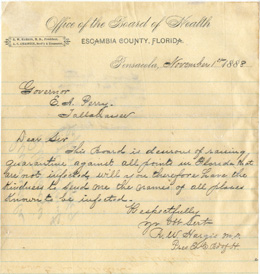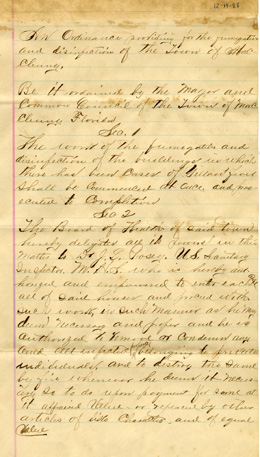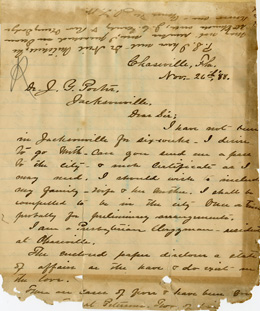Pestilence, Potions, and Persistence Early Florida Medicine
Epidemic Disease and the Establishment of the Board of Health
Yellow Fever, Hookworm, and Clean Cities
Travel within the State
Travel between areas of the state was essential for trade and commerce. Florida struggled to assure its own people, and the rest of the country, that effective measures were in place to prevent spread of yellow fever. Meanwhile, local governments strived to maintain social and economic activity.
Escambia County Board of Health
The president of the Escambia County Board of Health wrote to Governor Perry on November 1, 1888, to ask for a list of all the places infected with yellow fever in the interest of “raising the quarantine against” areas that were not, since the county had already experienced an outbreak itself.
The Board was making its own efforts to protect other areas of the state, even while staying in contact with what cities and counties it could to allow for the limited commerce essential for economic survival and to obtain essential supplies.
Who is Communicating with Whom?
Without a state official charged with coordinating state efforts, the county boards regularly reported directly to the governor.
This process of direct communication with the governor made it difficult for county boards of health to share information between themselves and hampered the vital need to communicate possible outbreaks with other states.
The inefficiency of county boards and lack of statewide organization brought criticism from other states, particularly those facing possible yellow fever outbreaks such as Texas and Louisiana, and became the most compelling evidence for the establishment of a State Board of Health.
Putnam County Board of Health
The secretary of the Putnam County Board of Health reported to Governor Perry that the county had successfully kept itself free of yellow fever, but also that the quarantine had cost the county and city of Palatka a total of $12,500.
Whether it was the quarantine that kept the county healthy is not questioned, but the financial burden and work load placed on the county for the protective measures were enormous.
Ordinance Pertaining to the Destruction, Disinfection, and Sanitation of "Infected Property"
This is an ordinance, passed by the city council of MacClenny, Florida, December 18, 1888, and approved by the mayor the next day, instituting an immediate disinfection and sanitation regime, and conferring upon the a federal “Sanitary Inspector” all of the power to carry out the measures, normally held by the local Board of Health.
The ordinance made clear the intention to replace items destroyed in the course of disinfection, while putting in place the possibility of imprisonment or a $100 fine for failure of property owners to comply with the demands of the U.S. Inspector, Dr. J.L. Posey of the Marine Hospital Service.
The ordinance illustrates the necessity of a direct relationship between local authorities and the national Marine Hospital Service prior to the establishment of the State Board of Health. It also shows how rigid and stringent the disinfection and inspection measures sometimes were.
Letter to Dr. Joseph Y. Porter on Government Relief Regulations
The writer identifies himself as J. T. W., a Presbyterian clergyman from Jacksonville currently living with his family in Chaseville, Florida.
In this letter to Dr. Joseph Y. Porter, a physician from Key West who was coordinating relief efforts in Jacksonville, the writer lodges another complaint about "Mr. Peterson" endangering his neighbors. The writer requests permission to re-enter the city of Jacksonville, asserting that since Peterson and his family pass back and forth, any effectiveness the quarantine had has already been compromised.
The clergyman needed to visit the city to make arrangements for his family's eventual permanent return, but he also uses the request to convey a paper of complaint written with other refugee residents about the actions of Peterson and the school teacher charged with caring for the children of yellow fever refugees.

 Listen: The Blues Program
Listen: The Blues Program



